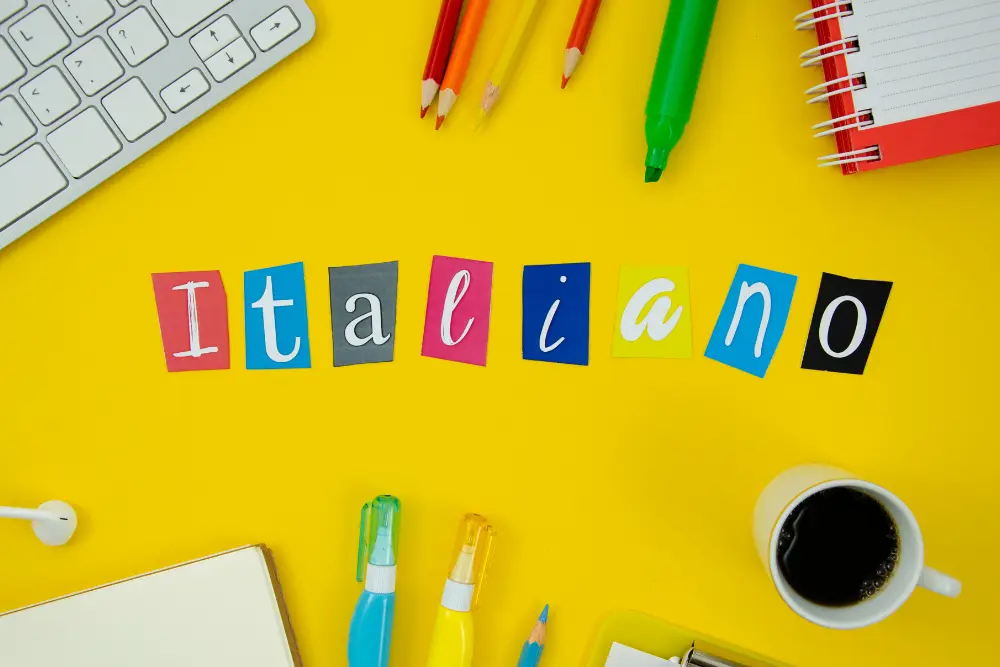Do you want to learn the fundamentals of the Italian language and establish a solid foundation for speaking, learning, and having fun? Whether you are just starting to learn or have been studying the Italian language for a while, understanding the basics of Italian grammar and how to apply them effectively is essential. This guide sets out the fundamentals of Italian grammar in clear, accessible language that will open the door to clarity, confidence, and fluency. Ready? Cominciamo!
Key components of Italian grammar
Italian grammar revolves around a few key components that bring the language to life. Verbs are dynamic and heavily conjugated, changing forms based on tense, mood, and subject. With both regular and irregular patterns, they are arguably the most complex feature of the Italian language.
Nouns are gendered (masculine or feminine) and numbered (singular or plural), which influences the form of the adjectives and articles that must agree with them. Sentence structure, on the other hand, is generally flexible, although it does follow a default subject-verb-object order.
There’s a lot to grasp. But mastering all these elements will help you form cohesive and grammatically correct sentences, which are essential for clear communication.
Italian sentence structure basics
Subject-verb-object (SVO) pattern
Italian, like English, is SVO in its word order. In other words, sentences typically start with the subject, have a verb, and include the object. For instance, “io mangio la pizza” (I eat the pizza) can be broken down into the elements “io” (subject), “mangio” (verb), and “la pizza” (object).
But Italian is more flexible than English, and the subject can be dropped entirely when the ending on the verb conveys sufficient information about who or what the subject is. Mangio la pizza, for example, means “I eat the pizza” (even though there is no “I” (io) in the sentence). Here, the conjugated verb mangio is used for the first-person subject. It’s a pattern that lies at the heart of the majority of basic sentences, so it is an ideal place for new learners to begin.

Flexibility in word order
How to play with word order. Italian word order is so flexible that one can change and rearrange it to stress some parts of a sentence or to fit into a context. The default word order is subject-verb-object, but things can move around the sentence to emphasize certain parts. For instance, “La pizza mangio io” (I eat the pizza) focuses more on the thing being eaten, la pizza.
Verbs also come first, in questions or poetic language: Mangio io la pizza? (Am I eating the pizza?). This flexibility is possible because verb conjugations tell us what we need to know about which noun in the sentence is functioning as the subject.
Understanding Italian verbs
Verb conjugations
Italian verbs in the infinitive have a specific ending: are, –ere, or –ire, and form a particular system of conjugation. With the endings of regular verbs, it’s a piece of cake; they are subject-specific and tense-specific. But there are some irregular verbs, such as essere (to be) and avere (to have), that don’t adhere to these rules, and their conjugations will need to be learned separately. This system of basic verb groups is vital to understand because a verb’s conjugation conveys who is doing an action and when they’re doing it.
Common tenses
There are a host of verb tenses in Italian, but beginners would do well to concentrate on the most used: present tense (parlo – I speak), past tense (ho parlato – I spoke/have spoken), and future tense (parlerò – I will speak).
As you progress in your learning, you’ll come across other tenses and moods: the imperfect (imperfetto) for descriptions or actions that were repeated in the past and the subjunctive (congiuntivo) for expressing doubt or emotions. Tenses that are rarely used, including the future perfect and past anterior, are largely limited to formal writing or literature, so that you can put those off as well. You’ll need to start with the basics to gain confidence and slowly build your way up.
Italian nouns and articles
Gender and number
Gender and number are relevant for the Italian noun. Masculine nouns commonly terminate in -o and feminine in -a; the most common way to make a noun plural is to change its ending from the masculine -o to -i, and from the feminine -a to -e; some nouns have two forms for the gender, for example words ending in -e; this ending belongs indistinctly to both genders, so in the plural changes to -i. Knowing these patterns is vital to conjugate articles, adjectives, and nouns correctly. Here are some examples:
- il libro (the book) → I libri (the books)
- la casa (the house) → le case (the houses)
- il fiore (the flower) → i fiori (the flowers)
Definite and indefinite articles
Italian articles match the gender and number of the nouns they accompany. Definite articles (various forms of “the”):
- il libro (the book) → masculine singular
- lo zaino (the backpack) → masculine starting with z or s + consonant
- La casa (the house) → feminine singular
- l’arancia (the orange) → feminine starting with a vowel
- i libri (the books) → masculine plural
- gli zaini (the backpacks) → masculine plural before vowels or specific consonants
- le case (the houses) → feminine plural
Indefinite articles (“a/an”):
- un libro (a book) → masculine
- uno zaino (a backpack) → masculine starting with z or s+consonant
- una casa (a house) → feminine
- un’arancia (an orange) → feminine starting with vowel

Mastering Italian adjectives
Agreement with nouns
Italian adjectives must agree with the nouns they describe in both gender (masculine or feminine) and number (singular or plural):
- Un libro interessante (An interesting book)
- Due libri interessanti (Two interesting books)
- Una casa bella (A beautiful house)
- Un giardino bello (A beautiful garden)
Adjectives usually follow the noun, but some, like bello or grande, can precede it, often altering the emphasis or tone.
Common adjective endings
The endings for adjectives are –o, –a, –e and –i, according to the gender and number of the noun they refer to. Like we’ve seen before: single masculine words end with -o and get -i in the plural. Feminine adjectives singular end in -a and become -e when plural. Adjectives ending in -e can be used for both masculine and feminine singular nouns; in the plural, they become -i.
Italian pronouns
Subject pronouns
Subject pronouns in Italian, including io (I), tu (you), and lui/lei (he/she), indicate who is acting. Unlike in English, they are often dropped because the verb conjugation already makes clear the subject (parlo means “I speak” without needing io). However, pronouns can be used for emphasis, e.g., Io parlo! (I am the one speaking!).
Italian also has different forms of “you”: “tu” for informal settings, “Lei” (always capitalized) for formal situations, and “voi” for addressing a group. Understanding when to use or drop pronouns helps make your Italian more natural and balanced.
Reflexive pronouns
Reflexive Pronouns such as mi (myself)? Ti (yourself) and si (himself/herself/itself) are used when the subject and object of a verb are the same. They are paired with reflexive verbs, with the pronoun kind of bouncing the verb’s action back onto the subject. These pronouns are frequently used to discuss everyday activities and describe personal actions. For example:
- Mi alzo alle 7. (I get up at 7.)
- Si lava le mani. (He/She washes their hands.)
- Ti diverti? (Are you having fun?)
- Italian grammar advanced concepts
The subjunctive mood
The congiuntivo is a tense used to convey possibility, doubt, or to express hypothetical situations. It’s usually set off by phrases like spero che … (I hope that …) or è importante che … (it’s vital that …). The subjunctive is different from the indicative (which you know), for the indicative is the mood of fact, while the subjunctive is the mood of possibility or the subjective.
Spero che tu venga. (I hope that you come.)
Conditional sentences
Conditional sentences express situations and their results graphically. They generally employ a conditional mood verb (condizionale), for example, vorrei (I would like). If it’s polite requests, wishes, or unreal situations, then use the conditional sentences.
Se avessi tempo, andrei al mare. (If I had time, I would go to the beach.)
Why These 12 Rules Matter
All of the Italian Grammar rules, in all, end up as a concise and powerful toolkit. So, whether you’re forming sentences, telling time, asking questions, or giving absolute directions, the sooner you get comfortable with these rules, the sooner you’ll have the basics of Italian grammar under your belt! So, from here, you can dive into the advanced concepts, sign up for the Italian language class, and learn basic Italian the way it was meant to be understood.
Tips to Reinforce Your Grammar Knowledge
- Flashcards & Spaced Repetition: Make flashcards for conjugations, pronouns, and prepositions — try an app like Anki.
- Repeat & Context: Write mini conversations or short paragraphs using 1 rule at a time.
- Speaking Practice Every Day: Utilize resources like iTalki or local classes to help with pronunciation and structure.
- Watch and Analyze: Focus on structure with TV shows, news, or YouTube videos. Be mindful of the use of pronouns, verbs, and prepositions.
- Maintain a Grammar Notebook: Take a section of each rule. Writing the information down helps it stay in memory and facilitates review.
Integrate Grammar into Your Journey
Grammar is not just rules — it’s how you build the structure that allows you to express thoughts, ideas, and emotions. Learn these sleek 12 rules and you will be able to:
- Confidently learn basic Italian language
- Grammatical Basics of the Italian Language.
- Use Italian grammar in actions and keep practicing every day
- Do well in Italian by being ready for class
About Language Learnings
If you are serious about getting better at all aspects of writing and speaking, then join Italian Language course online at Language Learnings. This platform offers personalized tutoring and flexible courses, taught by experienced instructors who will support you throughout your Italian studies. Here’s what separates Language Learning from the pack:
- Inexpensive trial lessons allow you to try the waters with no commitment.
- A selection of tutors and courses, from conversational Italian to grammar-based sessions.
- Bespoke learning journeys tailored to your pace, objectives, and curiosities.
- An interactive environment to practice with fellow learners and locals.
Whether you’ve just completed our 12‑rule jumpstart or you’re already studying, Language Learnings is the perfect complement to your grammar journey. Visit our website, view the available tutors, and start with a free trial to find your ideal match. A class is all that stands between you and Italian fluency!
Final Thoughts
Italian Grammar doesn’t have to be scary. Here are just 12 basic rules to get you on the right track. And use them all the time while practicing writing, reading, and speaking. And then add quality instruction on top of that, such as what you’ll get at Language Learnings — and watch your Italian skills bloom.






